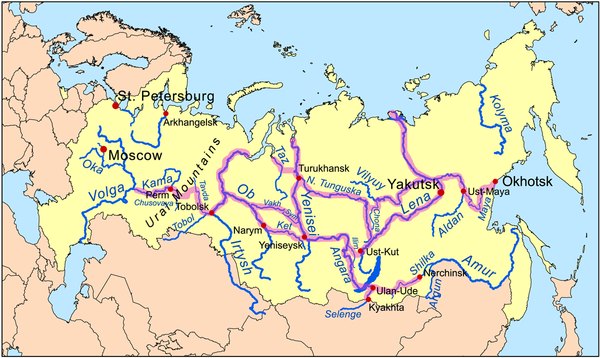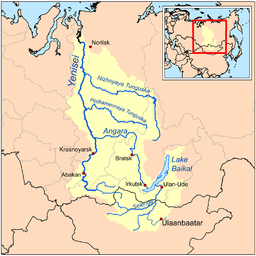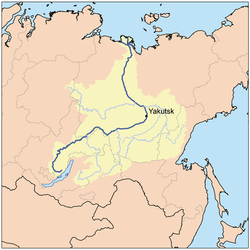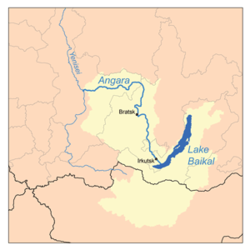
Demid Pyanda
Encyclopedia

Russia
Russia or , officially known as both Russia and the Russian Federation , is a country in northern Eurasia. It is a federal semi-presidential republic, comprising 83 federal subjects...
n explorers of Siberia
Siberia
Siberia is an extensive region constituting almost all of Northern Asia. Comprising the central and eastern portion of the Russian Federation, it was part of the Soviet Union from its beginning, as its predecessor states, the Tsardom of Russia and the Russian Empire, conquered it during the 16th...
. According to few historical documents and later reconstructions based on them, Pyanda, in 1620-1623, while leading a party which was hunting for Siberian furs and buying them from the locals, became the first known Russian to ascend the Lower Tunguska River and reach the proximity of the Lena
Lena River
The Lena is the easternmost of the three great Siberian rivers that flow into the Arctic Ocean . It is the 11th longest river in the world and has the 9th largest watershed...
, one of the world's greatest rivers. According to later legendary accounts, collected a century after his journey, Pyanda allegedly discovered the Lena River
Lena River
The Lena is the easternmost of the three great Siberian rivers that flow into the Arctic Ocean . It is the 11th longest river in the world and has the 9th largest watershed...
, explored much of its length, and via the Angara River
Angara River
The Angara River is a long river in Irkutsk Oblast and Krasnoyarsk Krai, south-east Siberia, Russia. It is the only river flowing out of Lake Baikal, and is the headwater tributary of the Yenisei River....
returned to the Yenisey, whence he came.
Thus, in three and a half years from 1620-24 Pyanda explored some 1,430 miles (2,300 km) of the Lower Tunguska
Lower Tunguska
Nizhnyaya Tunguska — is a river in Siberia, Russia, flows through the Irkutsk Oblast and the Krasnoyarsk Krai. The river is a right tributary of the Yenisei joining it at Turukhansk . Settlements on the river include Tura, Yukti and Simenga...
's length, and possibly some 1,500 miles (2,400 km) of the Lena
Lena River
The Lena is the easternmost of the three great Siberian rivers that flow into the Arctic Ocean . It is the 11th longest river in the world and has the 9th largest watershed...
and some 870 miles (1400 km) of the Angara
Angara
The Angara River is a long river in Irkutsk Oblast and Krasnoyarsk Krai, south-east Siberia, Russia. It is the only river flowing out of Lake Baikal, and is the headwater tributary of the Yenisei River....
(the Lower Tunguska and Angara both are Yenisey's largest tributaries). In total, Pyanda may have discovered about 5,000 miles (8000 km) of hitherto unknown large Siberian rivers. He may have discovered Yakutia and was possibly the first Russian to meet Yakuts
Yakuts
Yakuts , are a Turkic people associated with the Sakha Republic.The Yakut or Sakha language belongs to the Northern branch of the Turkic family of languages....
as well as Buryats
Buryats
The Buryats or Buriyads , numbering approximately 436,000, are the largest ethnic minority group in Siberia and are mainly concentrated in their homeland, the Buryat Republic, a federal subject of Russia...
. He also proved that the Angara
Angara
The Angara River is a long river in Irkutsk Oblast and Krasnoyarsk Krai, south-east Siberia, Russia. It is the only river flowing out of Lake Baikal, and is the headwater tributary of the Yenisei River....
(a Buryat name) and Upper Tunguska (Verkhnyaya Tunguska, as initially known by Russians) are one and the same river.
Name and identity


Fur
Fur is a synonym for hair, used more in reference to non-human animals, usually mammals; particularly those with extensives body hair coverage. The term is sometimes used to refer to the body hair of an animal as a complete coat, also known as the "pelage". Fur is also used to refer to animal...
brim of malitsa, which was a kind of Samoyed
Samoyedic peoples
The term Samoyedic peoples is used to describe peoples speaking Samoyedic languages, which are part of the Uralic family. They are a linguistic grouping, not an ethnic or cultural one. The name derives from the obsolete term Samoyed used in Russia for some indigenous peoples of Siberia...
ic clothes made from reindeer
Reindeer
The reindeer , also known as the caribou in North America, is a deer from the Arctic and Subarctic, including both resident and migratory populations. While overall widespread and numerous, some of its subspecies are rare and one has already gone extinct.Reindeer vary considerably in color and size...
skin. Pyanda was made from dog fur of different colours and was added to malitsa for beauty.
In the first third of the 17th century there were two men in Yakutia with the nickname Pyanda. One was Pyanda Safonov (the son of Safon, or Sofon) named Demid – his name appeared in documents in 1637. The other was Panteley Demidovich Pyanda (probably a son of Pyanda Safonov) – his name was recorded in 1643. The great explorer most likely was named Demid Sofonovich Pyanda.
Only a few original documents on Pyanda exist, and his deeds are mostly known by the records collected some 100 years later, in the 18th century, especially during the Great Northern Expedition
Great Northern Expedition
The Great Northern Expedition or Second Kamchatka expedition was one of the largest organised exploration enterprises in history, resulting in mapping of the most of the Arctic coast of Siberia and some parts of the North America coastline, greatly reducing the "white areas" on the maps...
, launched by the Russian government to establish the Arctic and Pacific coastline of Russia and find a way to the Americas
Americas
The Americas, or America , are lands in the Western hemisphere, also known as the New World. In English, the plural form the Americas is often used to refer to the landmasses of North America and South America with their associated islands and regions, while the singular form America is primarily...
. At the same time, the so called Academic Squad of that expedition pioneered the research of the Siberian nature and history.
The German-born historian Gerhardt Friedrich Müller
Gerhardt Friedrich Müller
Gerhard Friedrich Müller was a historian and pioneer ethnologist.-Biography:He was educated at Leipzig.In 1725, he was invited to St. Petersburg to co-found the Imperial Academy of Sciences...
found a document in the Siberian archives, proving that the winter settlement Pyandino on the upper part of the Lower Tunguska already existed in 1624, which meant that it had been established at least a year before.
The legend of Pyanda and his journey on the Lena and Angara was recorded by naturalist Johann Georg Gmelin
Johann Georg Gmelin
Johann Georg Gmelin was a German naturalist, botanist and geographer.- Early life and education :Gmelin was born in Tübingen, the son of an professor at the University of Tübingen. He was a gifted child and begun attending university lectures at the age of 14. In 1727, he graduated with a medical...
(another German in the Russian service), while he was travelling in the regions of the Yenisey and Lena
Lena River
The Lena is the easternmost of the three great Siberian rivers that flow into the Arctic Ocean . It is the 11th longest river in the world and has the 9th largest watershed...
. Müller also recorded some legends about Pyanda in Siberia.
On the basis of the Cossack hearsay stories, the document about Pyandino and a few mentions of Pyanda's name in other documents academician Alexey Okladnikov reconstructed Pyanda's alleged journey, as it is presented below.
Ascent of the Yenisey and Lower Tunguska
Demid Sofonovich Pyanda came to prominence in MangazeyaMangazeya
Mangazeya was a Northwest Siberian trans-Ural trade colony and later city in the 16-17th centuries. Founded in 1600, it was situated on the Taz River, between the lower courses of the Ob and Yenisei Rivers flowing into the Arctic Ocean....
around 1619, coming there from the Yeniseysk
Yeniseysk
Yeniseysk is a town in Krasnoyarsk Krai, Russia, located on the Yenisei River. Population: 20,000 .Yeniseysk was founded in 1619 as a stockaded town—the first town on the Yenisei River. It played an important role in Russian colonization of East Siberia in the 17th–18th centuries...
y ostrog. He had some money and riches of unknown origin. Taking about 40 men with him, he went to Turukhansk
Turukhansk
Turukhansk is a village in Krasnoyarsk Krai, Russia. It is located 1474 km north of Krasnoyarsk, at the confluence of the Yenisei and Lower Tunguska rivers. The Turukhan River joins the Yenisei about 20 km northwest. Population: 4,849 ; 8,900 ; 200...
on the Yenisey near the mouth of the Lower Tunguska
Lower Tunguska
Nizhnyaya Tunguska — is a river in Siberia, Russia, flows through the Irkutsk Oblast and the Krasnoyarsk Krai. The river is a right tributary of the Yenisei joining it at Turukhansk . Settlements on the river include Tura, Yukti and Simenga...
(or Nizhnyaya Tunguska in Russian
Russian language
Russian is a Slavic language used primarily in Russia, Belarus, Uzbekistan, Kazakhstan, Tajikistan and Kyrgyzstan. It is an unofficial but widely spoken language in Ukraine, Moldova, Latvia, Turkmenistan and Estonia and, to a lesser extent, the other countries that were once constituent republics...
). While buying fur
Fur
Fur is a synonym for hair, used more in reference to non-human animals, usually mammals; particularly those with extensives body hair coverage. The term is sometimes used to refer to the body hair of an animal as a complete coat, also known as the "pelage". Fur is also used to refer to animal...
s from the locals there, he heard stories about a large river to the east of the Lower Tunguska, called Elyu-ene, which in Evenk language
Evenk language
Evenki is the largest member of the northern group of Tungusic languages, a group which also includes Even, Negidal, and Oroqen language...
means "large river". Russians, in their own manner, rendered it to Lena (a shorter form of the Russian feminine name Yelena
Elena (name)
Elena is a popular Macedonian, Spanish, Romanian and Italian version of the Macedonian name Elena , meaning "light" and "beautiful". The name also means "love" or "happiness"....
, corresponding to Helen).
According to some notes made by Englishmen in Pustozersk in 1611-1612, Siberian Cossacks knew about the existence of Lena already in 1611-1612. Many wanted to find this yet legendary Lena River and its plentiful fur riches, however at the same time another kind of story appeared, telling of a great river to the east, where large ships with bells and cannons were sailing. This may have referred to Chinese ships on the Amur River, not the Lena, but the Russians were still unaware that there were two different major rivers east of Yenisey. The tales of armed ships made the Russian adventurers more careful and slow in their movement eastward.

Lower Tunguska
Nizhnyaya Tunguska — is a river in Siberia, Russia, flows through the Irkutsk Oblast and the Krasnoyarsk Krai. The river is a right tributary of the Yenisei joining it at Turukhansk . Settlements on the river include Tura, Yukti and Simenga...
with many men on several strug boats. They moved rather quickly amid the taiga-covered banks of the river, until the river's course turned south and the valley narrowed. Tree trunks, floating down the river, impeded the way – Pyanda thought the Tunguses were trying to force him to turn around. Wanting either to avoid excessive risks or to buy furs from the locals right at the point they had already reached, Pyanda ordered his men to stop and build a winter settlement, later called Nizhneye Pyandino (Lower Pyandino). It was in the region where the Lower Tunguska
Lower Tunguska
Nizhnyaya Tunguska — is a river in Siberia, Russia, flows through the Irkutsk Oblast and the Krasnoyarsk Krai. The river is a right tributary of the Yenisei joining it at Turukhansk . Settlements on the river include Tura, Yukti and Simenga...
is close to Vilyuy
Vilyuy
The Vilyuy River is river of the Central Siberian Plateau, longest tributary of the Lena River.At a length of approximately 2,650 km long, it is mostly within the Sakha Republic...
, a major tributary of the Lena. Tunguses indeed soon made several attacks, however the Russians easily repelled them with firearms.
The next year, 1621, Pyanda sailed only several dozen kilometers up the river, and at 62°N he built Verkhneye Pyandino, another winter settlement. In 1623 he sailed south several hundred kilometers more and yet again stayed at the winter settlement, at 58°N. Such slow pace of his journey is explained either by the resistance of Tunguses or by successful fur trade with them.
Discovery and exploration of the Lena

Lena River
The Lena is the easternmost of the three great Siberian rivers that flow into the Arctic Ocean . It is the 11th longest river in the world and has the 9th largest watershed...
or built new boats where he was, soon reaching this great river of Eastern Siberia.
After the ice on Lena had cracked and floated down the river, Pyanda followed it and for several days sailed through rocky banks. After passing the mouth of the right tributary called the Vitim
Vitim
Vitim is an urban locality in Lensky District of the Sakha Republic, Russia, located on the left bank of the Lena River at the confluence with the Vitim River...
, the Lena became wider and soon turned east, flowing amid the low banks and numerous islands. After passing the mouth of another southern tributary, the Olyokma, the banks again became rocky. Pyanda reached the lands inhabited by the Yakuts
Yakuts
Yakuts , are a Turkic people associated with the Sakha Republic.The Yakut or Sakha language belongs to the Northern branch of the Turkic family of languages....
and turned back, avoiding a wintering amid the yet unknown race of people.
Exploration of the Angara

Buryats
The Buryats or Buriyads , numbering approximately 436,000, are the largest ethnic minority group in Siberia and are mainly concentrated in their homeland, the Buryat Republic, a federal subject of Russia...
.
In autumn of 1623 Pyanda's party reached the upper Angara
Angara River
The Angara River is a long river in Irkutsk Oblast and Krasnoyarsk Krai, south-east Siberia, Russia. It is the only river flowing out of Lake Baikal, and is the headwater tributary of the Yenisei River....
and still had some time to build new boats, since Angara usually freezes rather late. Pyanda and his men successfully passed the Angara rapids and finally reached the mouth of the river at Yenisey, having discovered that the Angara is the same river as the Upper Tunguska (Verkhnyaya Tunguska), as it was previously named by Yeniseyan Cossacks. In the late 1623 or in early 1624 Pyanda reached Yeniseysk
Yeniseysk
Yeniseysk is a town in Krasnoyarsk Krai, Russia, located on the Yenisei River. Population: 20,000 .Yeniseysk was founded in 1619 as a stockaded town—the first town on the Yenisei River. It played an important role in Russian colonization of East Siberia in the 17th–18th centuries...
where his 5,000 mile (8000 km) long journey ended.
Later Pyanda's name was once mentioned in the Cossack documents, however his further life is unknown.
Pyanda's priority in the Lena discovery
Raymond Henry Fisher wrote in his 1943 work (before the 1949 publication of Okladnikov), that the Lena had been reached in 1620 by men from Mangazeya, who descended the Vilyuy River to its confluence with the Lena. This corresponds to the first year of Pyanda's journey as reconstructed by Okladnikov, but there is no conclusive evidence that Pyanda or his men reached Lena that early, while the existence of the Pyandino settlement near the confluence of the Lower Tunguska and Lena suggests that Pyanda more likely discovered Lena that way.While many sources name Pyanda or Penda as the first known explorer of Lena, others start the account of Lena's exploration from Vasily Bugor's name. Bugor was not the first Russian on the Lena, but his journey was the first well attested one, and the very first via the Angara
Angara River
The Angara River is a long river in Irkutsk Oblast and Krasnoyarsk Krai, south-east Siberia, Russia. It is the only river flowing out of Lake Baikal, and is the headwater tributary of the Yenisei River....
and Kirenga River
Kirenga River
Kirenga River is a river in Irkutsk Oblast in Russia, a right tributary of the Lena which flows north between the upper Lena and Lake Baikal. The length of the river is 746 km. The area of its basin is 46,600 km². The Kirenga River freezes up in the late October - early November and...
s. Between Pyanda's journey in 1620-24 and Bugor's voyage in 1628-30, attempts to reach the Lena were made by several other explorers. Grigory Semyonov sought the Lena in 1625 (one of his men, Matvey Parfyonov is thought to have reached the river); Bazhen Kokoulin traveled to the Lena in 1626 and Martemyan Vasilyev in 1627-28. All of them descended to the Lena via its tributary the Vilyuy, unlike Pyanda or Bugor. Since 1632, when Yakutsk
Yakutsk
With a subarctic climate , Yakutsk is the coldest city, though not the coldest inhabited place, on Earth. Average monthly temperatures range from in July to in January. The coldest temperatures ever recorded on the planet outside Antarctica occurred in the basin of the Yana River to the northeast...
was established in the central Yakutia by Pyotr Beketov
Pyotr Beketov
Pyotr Beketov was a prominent Cossack explorer of Siberia and founder of many cities such as Yakutsk, Chita, and Nerchinsk.Beketov started his military service as a guardsman in 1624 and was sent to Siberia in 1627. He was appointed Enisei voevoda and proceeded on his first voyage in order to...
, the presence of Russians in the Lena region became continuous.
Sources
- И.П. Магидович, В.И. Магидович Очерки по истории географических открытий. Издание в 5 томах. Том 2, стр. 268-271. Москва, "Просвещение", 1983 // I.P. Magidovich, V.I. Magidovich. Notes on the History of Geographical Discoveries in 5 volumes. Vol.2, pp. 268–271. Moscow, Prosvescheniye, 1983.
- Окладников А.П. Пенда - забытый русский земплепроходец XVII века. - В сб.: Летопись Севера. М., Изд-во Главсевморпути, 1949, т. 1. // Okladnikov A. P. Penda - the forgotten Russian explorer of the 17th century. A part of: Northern Chronicle. Moscow, the publishing house of the Chief Directorate of the Northern Sea RouteChief Directorate of the Northern Sea RouteThe Chief Directorate of the Northern Sea Route , also known as Glavsevmorput, was a Soviet government organization in charge of the naval Northern Sea Route, established in January 1932 and dissolved in 1964.-History:The organization traces its roots to AO Komseveroput, a shipping company...
, 1949, vol. 1.

